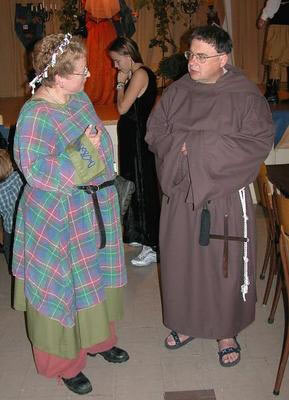|
The Franciscan Monk's Knot |

|
|
By Bryant Owen - Woodview, Ontario - Canada |
Paul Haynie’s article “Messing About with Monkey Fists“ reminded me about another knot I intended to write up for Duckworks. While not nearly as nautical or fancy as a Monkey’s Fist, the Franciscan Monk’s knot (aka heaving knot) is a good “duffer” knot - easy to tie or untie, works well as a stopper or heaving knot and I think has a certain salty look. I don’t’ know why it’s not in more common use. I’d never even heard of it until ….
Background
A few years ago my daughter informed me that she was planning a Medieval Wedding and asked the wedding party to dress in suitable costume. I decided to go as a Franciscan monk. I did a bit of research to make sure my costume was reasonably authentic. The habit was pretty straightforward (see photo below) but I needed to make sure I had the rest of the “bits” correct, including a monk’s haircut (tonsure), cross and rope belt.
Here’s what I found out about the rope belt.
In lieu of a leather belt, Franciscan Monks use a rope belt, called a cincture. Three knots tied in one end that hangs down on the right side are symbols of their vows (poverty, chastity and obedience). However the Franciscan Monk's knot traditionally used a stopper has no symbolic significance that I know. Best guess from me is that this knot, also known as a heaving knot gave the rope just enough weight to assure the rope hung straight at the side (keeps it out of the way) and helped identify them as Franciscans since other orders may have used rope belts. No doubt the knot itself was well known to many. I’d like to believe that early on an ordinary sailor took orders and used this knot on his belt and it caught with the others.
*How to tie the knot (Italics mine)
The Franciscan Monk's Knot
“A stopper and heaving knot, similar but more elegant than the common Stevedore knot. The size can be varied by the number of turns on the standing part of the rope.”
You may have to try this a few times before you get the knot shaped and tightened, as you desire. Also, you may wish to snip the pigtail off and tuck the end neatly inside the knot. A bit of super glue sometimes helps.
Here’s a picture of the knot in use, so to speak. That’s me, before losing 60 lb. The woman is dressed authentically as a Norman Lady. Yeah, I know, I got the rope hanging down the left. I got a “dispensation”.

About that Friar Tuck thing. As you can imagine, wearing a habit or cassock can be awkward at times, when running, climbing or riding a horse. In these cases a Friar would pull the back of the skirt through his legs and tuck it into his cincture. (Typically you were more likely to see a Friar about since they were essentially wandering preachers and monks tended to keep closer to home.) So people called a Friar with his skirts pulled up as a “tucked friar” which got changed around to Friar Tuck so in fact, there were lots of Friar Tucks. The term Friar Tuck probably tended to refer to men who were not monks or friars but disguised as such and these were likely charlatans pocketing alms for their own or men disguised to avoid arrest. In the tales of Robin Hood, Friar Tuck was probably one of the latter.
*The directions above for the Franciscan Monk's Knot are credited to the Canadian Sea Scouts at www.seascouts.ca which is where I found this:
"A ship's place in the line is not set
By the weight of her broadside,
The spread of her sails,
The strength of her scantlings,
But by the heart of those who sail in her."
Tom Oliver, Woodway, Waco, TX

Other articles by Bryant Owen:
Other articles about knots:
|